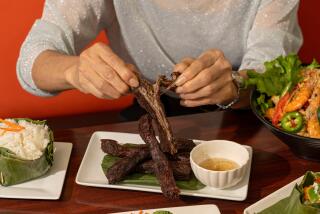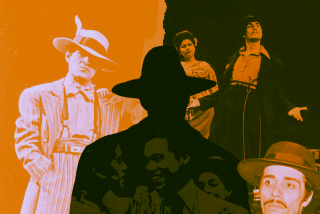But U.S. Pop Culture Makes Inroads : Burma Is Caught in a Time Warp
- Share via
RANGOON, Burma — On a recent Sunday morning in April, the country’s Europeans and Australians donned white trousers and straw hats, packed picnic baskets and assembled in a park under the scorching sun for what has become an enduring tradition from the days of the British empire: a friendly game of cricket.
With shanties forming a backdrop for the playing field and curious Burmese onlookers gathering on the park’s surrounding hills, the scene could have been taken from a page of Burma’s colonial past.
“In the prewar days, cricket was very bright in Rangoon,” said U Kyi Myint, secretary of the Burma Cricket Federation, who showed up to watch this yearly ritual. “Wherever there are foreigners, there is cricket.”
The Sunday cricket match seemed an anachronism strangely in place here, since Burma already appears frozen in a time warp from its days as a British colony. Few new buildings have emerged in Rangoon since the 1950s, and the surviving structures--although somewhat shabby now with peeling paint--provide a living example of traditional British architecture. The lobby of the once-gracious riverside Strand Hotel, with its columns and slowly whirling ceiling fans, looks untouched from the way it stood 40 years ago.
Traditions Held Fast
The people too have held fast to the old traditions. Virtually all of the men wear the traditional sarong, a cool, skirt-like wrap. Many of the women and children still paint their faces with the traditional white makeup that supposedly provides a guard from the blazing sun.
Even the cars crowding the main streets seem a throwback to the past, although a past not quite so distant. The Detroit relics are most popular, such as 1962 Chevrolet Impalas with tail fins, still seemingly in good working order. Because many of the cars are British antiques, with the steering wheel on the right, and many others are American, it is sometimes difficult to tell which side of the road is to be used. But for Burmese drivers, such details of highway safety seem trivial.
Burma’s military ruler, Ne Win, so far appears to have succeeded in keeping out much of the infectious modernity of the West. However, some cracks in Burma’s Bamboo Curtain are beginning to appear. “They’re not completely cut off from Western influences, but it’s not encouraged,” one diplomat said.
The biggest outside invader here has been Rambo, the American film hero portrayed by Sylvester Stallone. His movies are for sale and rent in most of Rangoon’s numerous video shops. His pictures, often life-sized and bare-chested but always strapped with bullets and cartridges, adorn the walls of several cafes and restaurants. Many Burmese have not heard of Michael Dukakis, but everyone knows Rambo.
Pop Culture Invasion
Rambo appears to be spearheading an American pop culture invasion that also has infiltrated music. American country-western music has become a recent favorite on Rangoon radio stations.
American pop culture has also found its way onto Burma’s single television channel, but the television invasion is far less up to date than the music scene. Recent offerings have included “Hart to Hart,” “The Rockford Files,” “Starsky and Hutch” and--a personal favorite of Ne Win, according to informed diplomatic sources--”Little House on the Prairie.”
Burma has managed to stay neutral and nonaligned, but it seems clear from the images on the streets that the average Burmese likes the United States. Many cars have small “USA” emblems and American flags and eagles stuck neatly on their doors or in the windshields. T-shirts with the names of American sports teams are commonly seen.
Part of this seeming fascination for things American has to do with the importance of the U.S. dollar, which has become the preferred currency in the street and on the freewheeling black market.
‘Like to Do Business?’
A foreign tourist walking down any street in the central part of this city must fend off hordes of followers who use the same general phrase: “Sir, would you like to do business?” They offer to exchange black market money at generous rates--up to 40 kyats (pronounced “chats”) per dollar. The official government rate is 6 to 1.
The black market has become so pervasive--and the government’s need for the hard currency so desperate--that foreigners flying into Burma are told to change at least $100 at the airport at the official rate.
Travelers who do not wish to play the black market game still find extra spending kyats through an old Burmese practice, selling items brought in duty-free. A carton of cigarettes can be sold on the streets for more than 250 kyats. Another favorite of the local hustlers is Johnny Walker Scotch whiskey, but only the Black Label, never the Red. The items are then resold in the black market shops at an even higher price.
The increasing number of American, European and Australian tourists bring dollars to spend here, but they also bring the corruptive influences of the West, which may explain the government’s apparent ambivalence toward tourism.
Corrupting Influence
“There’s an ambivalence that goes all the way to the top,” one diplomat said. “On the one hand, they see tourism as a source of foreign exchange, and they want to expose tourists to Burmese culture. The other side of the coin, they see tourists with their backpacks and shorts and long hair, and the young women with their breasts hanging out of halter tops, as corrupting the values of Burmese youth.
“They have a visceral dislike for foreigners, because they see them as all wanting to come in here and exploit the country. But it’s a view that’s 30 or 40 years out of date.”
More to Read
Sign up for The Wild
We’ll help you find the best places to hike, bike and run, as well as the perfect silent spots for meditation and yoga.
You may occasionally receive promotional content from the Los Angeles Times.






